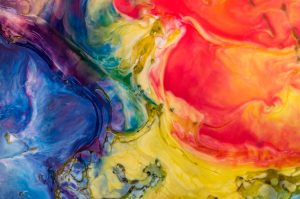 The following notes on the meanings of various colours have been taken largely from Schuon (1956) and Cirlot (1984) for the major references to symbolism whilst Sloane (1980), Varley (1980) and Gage (1993) were mainly used for the more contingent or subjective meanings.
The following notes on the meanings of various colours have been taken largely from Schuon (1956) and Cirlot (1984) for the major references to symbolism whilst Sloane (1980), Varley (1980) and Gage (1993) were mainly used for the more contingent or subjective meanings.
The meanings we see in colour at a very basic level appear to be part of the general human condition. This is not to say that all cultures see the same significance in the same colours – far from it. How various cultures put similar information to use in different ways is the hallmark of cultural diversity. The metaphysical origins of every culture remain the ultimate source of knowledge about it; any attempt to understand a culture which does not consider the metaphysical in a systematic way will be, at the very least, less than complete. This exploration must deal with symbolism.
The symbolic reading of colours, as of any phenomenon, must be an inclusive process which ‘throws together’ all aspects. It must be noted firstly that colour is a physical phenomenon and is experienced as such; its symbolism will be intimately related to its physical manifestation.
As with all aspects of existence, colours have both a positive and a negative dimension. Our reading of colour meaning in any context will be negotiated between their beneficent and maleficent aspects.
This list presents a most rudimentary introduction to the meanings of only a few colours. It is an extremely limited and highly selective list. For this reason it is offered hesitantly. Far too often such lists are used in a simplistic way, reducing a wonderfully complex and mysterious phenomenon to a mere parody of what sustains and renews the human spirit. The colours are arranged in the order in which they seem to be recognised in the language of any given culture.

BLACK
Positive meanings
Black is generally seen as having negative meanings. However, as with all colours, its meaning will depend upon its context and it can have positive meanings. Black represents the primal darkness or chaos (as opposed to cosmos or ordered creation) and therefore to pure potentiality – mysterious and powerful. It stands for all preliminary stages representing the descent into the underworld as an atonement for all that has gone before. It is therefore the colour of penitence in Christian symbolism. That Noah released a black crow before he released the white dove from the ark is an affirmation of black as the colour of the preliminary stage. Germination takes place in the secrecy of the darkness – there is therefore a connection with the blackness of the cave and the feminine aspect which is echoed in many traditions in many ways. Black also stands for time (as opposed to the timelessness of white). In its more contingent aspect, black has a certain dignity and stiff formality which is reflected in the black leather of the executive furniture, the black cassock of the clergyman and the gentleman’s formal evening wear.
Negative meanings
Of all the colours, black is the only one whose negative or malevolent nature is primarily the dominant one. Black is the colour of the night, inherently ominous, sinister, evoking spontaneous fear. It is the colour of death and mourning. The early Greek notion that light and life are synonymous has as its opposites, death and darkness – black is the colour of darkness par excellence. It is the colour of sin and evil. We talk of being in a state of black despair, in a black mood, on a blacklist, to be blackballed, to have one’s reputation blackened, to be black-hearted.
WHITE
Positive meanings
White, as the brightest of all colours, derives its significance from the sun, brightest light in our world whereby it symbolises mystic illumination. Symbolically it is also related to gold, the ‘brightest’ of all elements. The next brightest colour is yellow which, in its purified state, is like white. White in this way borrows from yellow its joyous meanings. The Christian burial is marked by the use of white vestments to symbolise the joy of the birth of the deceased into the next life. This is set against the background of black clothing with its connotations of sorrow and mourning. White is the obvious colour of purity. The white lily is the symbol par excellence of the Virgin Mary – the pure white receptacle – a symbolism that abounds in Christian art. White signifies timelessness when opposed to black in its meaning as time.
Negative meanings
White has the quality of lividness and as such is similar in its negative aspect to green or greenish yellow which in their negative meanings are the pallid colours of death. (White is the colour most often associated with death in Japanese culture). It is the colour of the moon and if the light of the sun is seen as positive, then its reflected light in the moon is its negative aspect. To send a white feather is to accuse someone of cowardice, a practice based on the notion that a white feather in a fighting cock’s tail was a sign of degenerate stock according to Varley (p. 178).

RED
Positive meanings
Red is the first colour to appear in the language after black and white (light, dark). It is the colour of blood and fire and has an obvious and immediate connection with passionate emotions, particularly with love. It is an aggressive colour with a ‘masculine’ nature and has always been linked to combat – Mars, the Red Planet and the god of war; the Roman general had his face painted red in triumphant processions. In Christian symbolism, red stands for charity and love. Red stands for the creative principle – the mother goddess of India is red. Red was seen as ‘the colour of light’ in Antiquity. In Aristotle’s colour-scale, red was placed next to light. It was seen as the colour of the sun until early medieval times. As to ‘be in the light’ was to ‘be alive’, red was seen as the colour of life, a direct correspondence with red as the colour of the creative principle. The Chinese culture makes abundant use of red where its connection to life, good fortune and happiness is emphasised and, combined with gold, signifies special happiness. With purple, red has always had regal connotations. Royal livery is commonly red and to ‘roll out the red carpet’ is to show the greatest respect, respect fit for royalty.
Negative meanings
Its passionate aspect may be seen as negative in its association with sexual lust and with crimes of passion. Whilst it is the colour of the sun it is also the colour of fire and therefore the colour of hell and Satan.
YELLOW
Positive meanings
Yellow is the happiest of colours. It is the colour of joy, particularly spiritual joy. It is the colour of gold and so has some of the meanings of red but not as passionately – rather more ‘light heartedly’. As the lightest of colours, it shares some of its meanings with white. Yellow symbolises enlightenment, the state sought by the Buddhist monk in robes dyed with saffron (which produces a slightly orange hue). It is the final colour on the alchemist’s series denoting the path of spiritual ascension – black, white, red and finally gold. In Chinese culture, yellow with its solar connotations is related to royalty.
Negative meanings
Yellow in its negative aspect has the malevolent symbolism of gold – greed and a lust for worldly riches and power. Medieval stained glass windows depict a yellow- clad Judas betraying Christ. In English it is generally reserved for negative metaphors – to have a yellow streak is to be cowardly. It is the colour of sickness (jaundice). Positive metaphors use the word gold rather than yellow – we have golden sunny days not yellow ones; yellow hair is called golden.
BLUE
Positive meanings
Blue suggests the vastness of the sky and the depth of the ocean. Deep and mysterious, feminine, blue is the colour of wisdom, quietude and contemplation. It is associated with spirituality, particularly female spirituality. The medieval artists used blue for the Virgin’s cloak for all of the above connotations and, in France, baby girls are often clothed in her colour. The great French medieval cathedral of Notre Dame (Our Lady) at Chartres has so much blue glass in the windows that the light within the building appears, quite aptly, to be blue.
Negative meanings
Unlike all other colours with the exception of white, blue cannot have any truly malevolent meanings. Its more or less negative meanings have to do with its darkness in comparison to its complementary yellow – blue stands to yellow as black stands to white, but only faintly. The cool deep darkness of blue is not the complete darkness of black. The depths of blue suggest melancholy rather than fear and dread.
GREEN
Positive meanings
Green, as the synthesis of blue and yellow, combines their meanings. The inward turning (contemplation) of blue when undertaken with a sense of joy (yellow) results in the hope symbolised by green. Green is the colour of hope, promise, happy awaiting and good news. Of the secondary mixed colours (green, orange and purple) it is the ‘first’ in that it is the most positive. Because of its two dimensions (yellow and blue) and its happy nature, it has a strangely surprising and mysterious quality. It is the colour of verdant growth, strongly suggestive of new life. In Christian art, it is often associated with Easter and the new life and hope promised by the resurrection of Christ. Paired with its complementary colour red which symbolises love, green stands for knowledge.
Negative meanings
Green is the colour of mould and decay, of death and rotting flesh. It is the colour of envy and jealousy, the perfidious and venomous.

ORANGE
Positive meanings
The combination of red and yellow produce a colour whose meanings spring from both to some degree. In orange, yellow loses its bright happy disposition and becomes a more sensual excited colour as it borrows some of the passion of red. It represents the joyous excitement of desire. It is evocative of the ripe fruit of late summer, a more mature colour than the youthful yellow but not quite yet the aged tawny colours of autumn.
Negative meanings
Orange has few negative meanings, mainly related to its aspect as an overheated heavy yellow. It is the colour of seduction. The greed for worldly riches (yellow) becomes more insidious as it takes on the lustful overtones of red.
PURPLE
Positive meanings
Purple combines the love symbolised by red with the wisdom symbolised by blue and marries them in the royal purple where they represent the two most desirable characteristics of the good monarch – the wise, caring ruler. To contemplative and cold blue is added the opposing blindly active and hot red to arrive harmoniously at a colour which retains much of the mysterious depth of blue but with a passionate smouldering dimension.
Negative meanings
Purple takes many of its negative connotations from black as it is the next darkest colour. Because the colours from which it is mixed are both ‘heavy’ colours, the resultant colour is ponderous and overloaded evoking fatigue and languor. It is the colour of regret and mourning.
BROWN
Positive meanings
Brown is a complex colour which is produced by a mixture of all of the primary hues. As such it can tend towards yellow (ochre), red (umber), green or blue while still being able to be identified as brown. It is the colour of clay and earth; it has a primary positive meaning associated with the potential of soil to support life. As the colour of clay it is linked to the origins of life, for clay is the primal matter from which life emerged (both in science and in the Biblical account of the creation).
Negative meanings
Its secondary and predominantly negative meanings are borrowed from its association with muddiness or impurity. Brown is the colour of faecal matter and of rotting humus and as such carries the meaning of death and decay.
PINK
Positive meanings
Pink naturally takes its major meanings from its parent colour red; however as it is muted by white and is clearly not as powerful, its meanings are similarly less intense. As the colour of flesh, it is seen to be a sensuous colour linked to the emotions and romantic love. It is the colour associated with the rose (Latin languages use the word rose for pink) and as such borrows some of the reserved, formal dignity of this noble flower.
Negative meanings
The few negative connotations of pink have to do with the consequences of an abandonment to the senses and to an unthinking surrender to the emotions.
MID GREY
Positive meanings
Mid grey is exactly half-way between black and white, strictly speaking colourless and as such is completely neutral having no meaning of its own. If being neutral or uncommitted is a positive attribute, it is well represented by mid grey. It evokes a state of equilibrium.
Negative meanings
The uncommitted nature of the colour may suggest a degree of concealment and therefore a measure of deceit. The pallor of death that is represented by white is clearly a significant aspect of grey.

POSTSCRIPT
Meanings Change with Change in Value of Colour
‘Tints’ and ‘shades’ are hues whose values have been changed. Tinted hues have been altered in value by the addition of white, while shaded hues have been altered in value by the addition of black or their complementary colour.
A tinted colour will generally be weaker in meaning taking account of the weakening effect of the white. This has been discussed above only in the case of PINK, however the same kind of reading may be made of all of the other colours. Meanings of shaded hues are also weaker but in a relatively more negative or malevolent sense.
Colour Context will Change Meaning
We rarely experience colours in isolation. Our experience of a particular colour is virtually always in context with other colours. Whilst all of the meanings listed above hold good for colours in isolation, the meanings will change according to the colour context in which they are experienced. Where red and blue are juxtaposed for example as they so often are in medieval stained glass, the startling contrast gives greater emphasis to both colours. The fiery opaque nature of red is magnified in contrast to the cool depths of adjacent blue whose qualities are similarly magnified by the juxtaposition.
HARRY STEPHENS, architect, taught interior architecture at the University of New South Wales for 40 years. His special interest is the design of sacred space.
Schuon, F, Spiritual Perspectives and Human Facts (London: Faber and Faber, 1956)
Cirlot, J E, A Dictionary of Symbols, 2nd edition, (London: Routledge & Kegan Paul, 1984).
Sloane, Patricia, The Visual Nature of Color (New York: Design Press, 1989)
Varley, Helen, ed, Colour (London: Mitchell Beazley Artists House, 1980)
Gage, J, Colour and Culture (London: Thames and Hudson, 1993)
